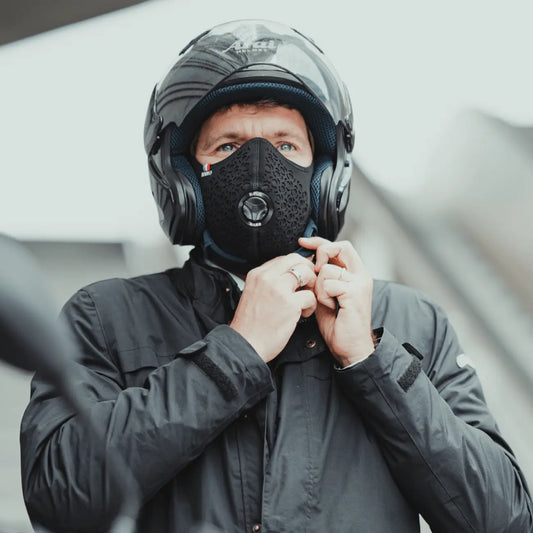
The urban cyclist's paradox: riding for your health... while breathing polluted air
Cycling in the city is a responsible choice. It's good for the planet, your wallet... and your health. But one question remains: is it really good for your health when you're breathing in air saturated with fine particles, ozone, nitrogen dioxide, and exhaust fumes?
Pollution, traffic, chronic fatigue... these are all warning signs that urban cyclists should no longer ignore. And among the solutions available at the handlebars, the anti-pollution mask for cycling is a must-have.
In this guide, we explain everything to you, simply and concretely, to regain control over what you breathe .
Pollution in the city: why cyclists are the first to be exposed
Did you know? On a bike, you breathe up to four times more air than in a car.
And unlike drivers protected by a passenger compartment, cyclists ride in the open road, often at exhaust level.
Result: increased exposure to fine particles (PM2.5, PM10), nitrogen oxides and volatile organic compounds.
This can explain several common symptoms:
-
Unusual fatigue even after short journeys
-
A runny nose systematically after driving in an urban area
Even if these effects seem harmless in the short term, their repetition is not without consequences for respiratory health.
To learn more, you can discover our articles dedicated to these symptoms:
What do we actually breathe when we cycle in the city?
Air pollution isn't just a gray cloud hanging over the city's main avenues. It's a multitude of invisible particles that penetrate deep into the respiratory tract:
-
PM2.5 fine particles : capable of reaching the pulmonary alveoli
-
Nitrogen dioxide (NO₂) : a respiratory irritant generated by diesel engines
-
Tropospheric ozone : formed under the effect of the sun, very present in summer
-
Volatile organic compounds (VOCs) : toxic in the long term
These pollutants are more concentrated at ground level , right where you breathe when you ride your bike...
Good habits to limit your exposure to pollution
Before even thinking about equipping yourself, it is possible to adopt simple habits to limit the inhalation of pollutants:
-
Choose the right routes : favor greenways, parks, small streets
-
Avoid rush hour , especially in winter
-
Adapt your pace : less effort = less deep breathing
-
Stay away from lines of stopped cars
The anti-pollution mask: essential equipment for the urban cyclist
Today, it is one of the only truly effective protections against air pollution.
But not all masks are equal .
The 3 criteria for choosing the right mask:
-
Filtration efficiency : FFP2, FFP3, activated carbon filter or nanofiltration
-
Adaptability : optimal support, seal without discomfort, adaptable to the face
-
Comfort of use : breathability, moisture wicking, easy maintenance
The benchmark anti-pollution cycling mask for cyclists
The R-PUR anti-pollution cycling mask is now the benchmark for urban cyclists looking for high-end protection . Thanks to its patented filtration technology, it offers a level of protection higher than the FFP3 standard, the most demanding in Europe. This mask is capable of filtering ultrafine particles, toxic gases, pollens, bacteria and other pollutants to which you are exposed every day in the city.
Designed for everyday cycling, it combines performance and comfort. Its memory foam molds perfectly to the contours of the face to ensure maximum sealing, while remaining comfortable to wear, even during long rides. Its ergonomic design fits naturally with most helmets and glasses, making it an ideal choice for regular cyclists who are concerned about their health.
This is a true ally in the fight against urban pollution. This high-tech device is designed to meet real mobility needs in polluted environments.
What other equipment can improve your breathing comfort?
In addition to the mask, other accessories can optimize your journeys in the city:
-
Filtering glasses to prevent eye irritation
-
A neck warmer or filter scarf to cover the throat and nose
-
Technical textiles that promote ventilation and limit heat
Cyclists, pedestrians: same fight against pollution
Urban mobility is evolving, and more and more of us are walking or using electric bikes.
But exposure to pollution remains the same — sometimes worse, because we stay longer on the main roads .
Solutions also exist for pedestrians to better protect themselves against urban pollution.
Conclusion: pedal freely, but consciously
Riding a bike is a powerful act: for you, for the city, for the planet.
But this choice should not be made at the expense of your health.
Today, it is possible to combine freedom and protection , thanks to simple actions and innovative equipment such as anti-pollution masks , designed especially for urban journeys.



